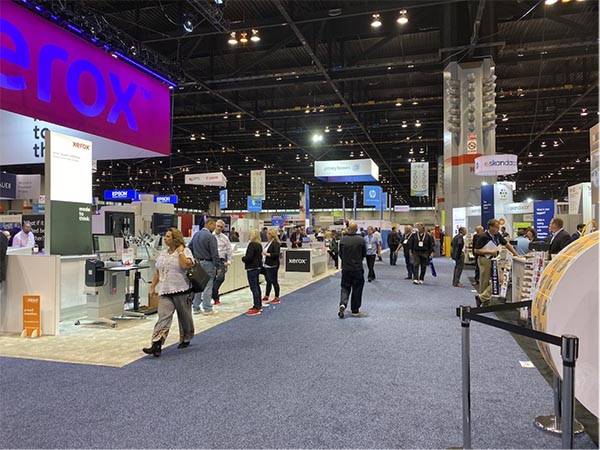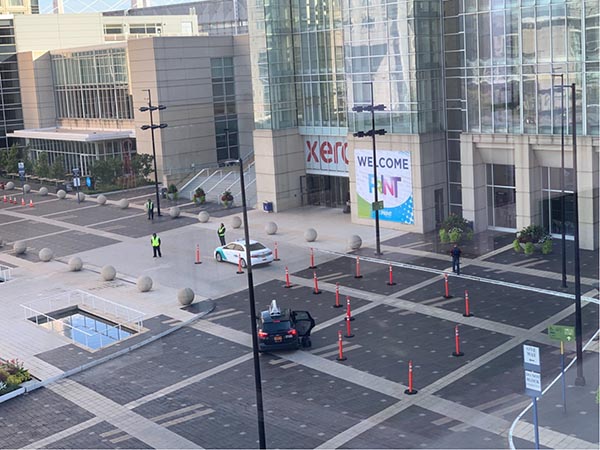While I wanted to do the follow up story on Labelexpo this week, after visiting PRINT 19 in Chicago last week, I felt I had to reflect on something timelier and more important. Sadly, this was to be the last of big Chicago print events.
Since the mid 1970s, I looked forward to my annual pilgrimage to the great city of Chicago for the alternating GRAPH EXPO and PRINT events. In the scheme of things, they were only print shows, but for me they became an annual time to reflect on the industry in which I have spent a large part of my life. These were welcoming events to see the latest hardware and software technologies and meet old and new friends. I recall one year when the show fully occupied both sides of the South Hall with some overflow to a third hall in order to accommodate the newly introduced digital print technology. This was in addition to the usual complement of offset presses, finishing equipment, and the necessary process support and consumable offerings. This year, PRINT 19 barely occupied a fraction of one side of the North Hall. Visiting the booths, going to seminar sessions, seeing the new developments and old friends in the hall was comforting and “normal.” I guess that in this rapidly changing world, normal is something we may have had to redefine to include constant change and transformation. The new normal.

Over the years, we have seen many printing and technology events disappear only to be replaced by others that, at least for a time, provide more relevance and timeliness. For a while, in addition to the big Chicago event, there were many regional printing shows to address the needs of the industry at that time of need, until travel became easier and they were all consolidated into the Chicago event. Some other industry events are there for a short period of time to help address significant changes. In the early to mid 1980s, when CEPS (Computer Electronic Prepress Systems) from companies like Scitex, Hell Graphics, and Crosfield began to show us how we could move from manual design and prepress to the new digital world at the Lasers In Graphics events. From 1985 to 1993, Macworld was a go-to event, as Apple became the dominant creative and production platform, until other computing platforms became relevant as well.
When digital technologies moved upstream into publishing and computers got smaller and more powerful, the CEPS systems lost their relevance and Seybold Seminars displaced Lasers In Graphics as the go-to event to learn and share. It ran from 1981 to 2005, but it too started to lose its relevance—or at least its economic viability. Seybold started its decline with the introduction of the Internet which started to have a significant impact on publishing. Seybold’s decline accelerated after there was a proclamation during a keynote address in 1999 that “print was dead.” Each of these events disappeared into the annals of history, print’s death was greatly exaggerated, and 20 years later the production processes and uses of print are just continuing to evolve to keep up with new technologies and meet new market requirements, and as we have previously seen, not for the first time.
As we have seen in the past, there are always other events that are willing to move in to address the current industry and its market trends and needs We are seeing a lot of more focused events like Hunkeler Innovationdays, which focuses not just on equipment but how it all fits together in a production line. Or Labelexpo, which just finished celebrating its 40th anniversary. Events on textiles, 3D printing (manufacturing), industrial print, inkjet, packaging, flexible packaging, etc., are all trying to get our focused attention as the markets are continuing to change and new opportunities are emerging. Of course, one of the oldest standing events is drupa, the colossal quadrennial event that has been turning Dusseldorf, Germany, into a printer’s Disneyland since 1951and is preparing for 2020. In a few weeks, we will see one of those previously focused events, SGIA Expo, which was historically a sign and graphics show, expand to address the broader market of print and offer a vision of print application and production convergence as the new PRINTING United.
Each of these events plays an important role in helping to define and support our industry during times of normalcy and, more importantly, times of change. Print technology and use are going through more major changes, somewhat akin to what we saw during the 1980s and 90s. Digital printing technologies, especially production inkjet, have created many new opportunities for print to become a part of a manufacturing process and not just an end product. That’s not to say that print as an end product is going away, it is just finding some new relevance as well.

However, even with the excitement of new events on the horizon, in speaking with many of the friends, exhibitors, and attendees I saw last week, there was a shared sadness. Our new normalcy is taking away a certain comfort and, sadly, Chicago.
More to Come…
I would like to address your interests and concerns in future articles as it relates to the manufacturing of Print, Packaging and Labels, and how, if at all, it drives future workflows including “Industry 4.0.” If you have any interesting examples of hybrid and bespoke manufacturing, I am very anxious to hear about them. Please feel free to contact me at [email protected] with any questions, suggestions or examples of interesting applications.










Discussion
By Andrew Schipke on Oct 08, 2019
David, I agree after attending the big Chicago print show since the 80’s that this years show had an element of sadness based on total turn out. I know in our pre-show marketing to our customers that many companies had decided to check out the Printing United show and did not attend PRINT19 because it was “new”. But, I have to say it may be premature to say we have seen the “last big Chicago print event” as Brand Print 2020 will be taking place in Chicago next year and this will combine the Label Expo trade show that focus on narrow web printing and finishing for the label and the growing packaging markets with that of the PRINT on two separate floors of Donald Stevens convention hall. Based on my read the total floor space of Brand Print 2020 will be north of 300,000 sq feet which will make it a much bigger printing show than we currently know in terms of space and exhibitors.
Without doubt everything you mentioned in your article has contributed to the fragmenting of the one big print show that encompassed print and I feel we are at a tipping point especially for those whoprint and convert paper. In my view this new normal as you call it and it may not be good for printing and finishing of paper based communications which is still a very significant market and has the supplier and user base that warrants a stage. Printing United is trying to bring everyone under the one tent approach but in my view based on the most current listing of exhibitors it has not succeeded in the mailing and to somewhat lesser degree for the finishing markets for commercial printing on paper. This is not to say that this will not change in future shows but it seem clear to me that the commercial printer on paper and significant markets like mail is a potential loser in this trade show wars that are going on.
Looking at the exhibitor makeup of the PRINT19 floor is saw that about 40% were focused in the mailing markets which had its own section of the hall and by my count a total of 65% of the exhibitors at PRINT had products that were solid into the mailing markets. Many of these exhibitors brought their latest technology and had it running which is a big part of the trade show attraction. PRINT also had a high concentration finishing machinery for the paper-based markets. So in my mind the PRINT19 show was a primarily a paper based mailing and finishing show which are growth driven by printing, coating, foiling etc. by not just digital print technology but to a higher degree more traditional flexo, and offset printing.
So, the question moving forward will be will the combined Brand PRINT show with Label Expo maintain a “big Chicago print show” that will be built around the segments like mail and paper finishing labels and packaging or will a Drupa like more encompassing print show like Printing United prevail? The message should be clear to trade show organizers that paper based print and finishing still are relevant and need a stage.
By David L. Zwang on Oct 08, 2019
Andrew.. as someone who was studied in the sciences, one of the most important laws is "if there is a vacuum, it will be filled". Now that the vacuum has been created.. again....it's time to see how it will be filled.
By Chris Lynn on Oct 08, 2019
David, your mention of Seybold reminded me of a presentation Alan Darling gave at one of their events in the late 80s. "This is what you guys call a printer" he said to the assembled 4th Wave aficionados, showing a picture of an Apple LaserWriter. Next slide: a 120 ft long, 20 ft high Cerutti press. "But this is what I call a printer".
The thought this memory prompts is that, not only is there a reduced number of businesses that buy and sell printing equipment, the square footage occupied by each printer displayed is also a fraction of what it used to be - and trade shows sell square feet.
By HARVEY LEVENSON on Oct 08, 2019
David, Excellent article.
I saw this occurring well before the event took place.
To be successful, the expo developers had better come up with new and creative approaches for OEMs to see value in investing and exhibiting, and for industry members to see value in attending. These expos must offer more than what one gets from online articles, reports, webinars, and OEM publicity. I offer an anecdote for example.
A number of years ago I missed either Graph Expo or PRINT due to my mother’s health situation. Following the event I asked myself: “What don’t I know now that I would have known had I attended?” My answer was “nothing,” because I followed all of the publicity, webinars, and other online coverage prior to, during, and after the event. Certainly, connecting with industry colleagues is always enjoyable. However, as far as the substance that the expo provided, I felt that I missed nothing. In having to select between this year’s PRINT 19 and PRINTING United, I selected the latter for a number of reasons. However, in planning future expos, I suggest that developers ask and answer the question: “What will I be offering of value that is not available through some other means?”
By Martin Bailey on Oct 08, 2019
To follow up on Chris' comment; I'm not seeing the vendors shipping the biggest presses (digital or offset) to trade shows these days, although many of the flexo presses are there because they're physically smaller. That's partly because the shows are shorter, and taking multiple weeks to build your booth doesn't make sense for most of them. As Dave says, travel is easier these days, so it's more viable to invite prospects to a dedicated demo facility (sorry, customer experience center!) to see the big beasts. And that has taken some of the excitement out of trade show visits.
Discussion
Join the discussion Sign In or Become a Member, doing so is simple and free